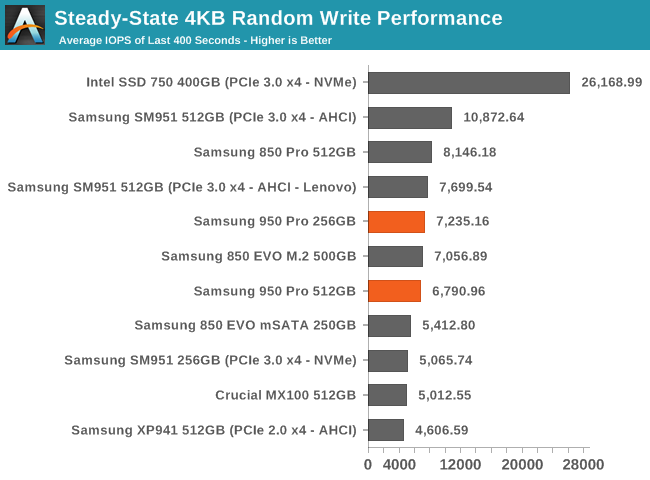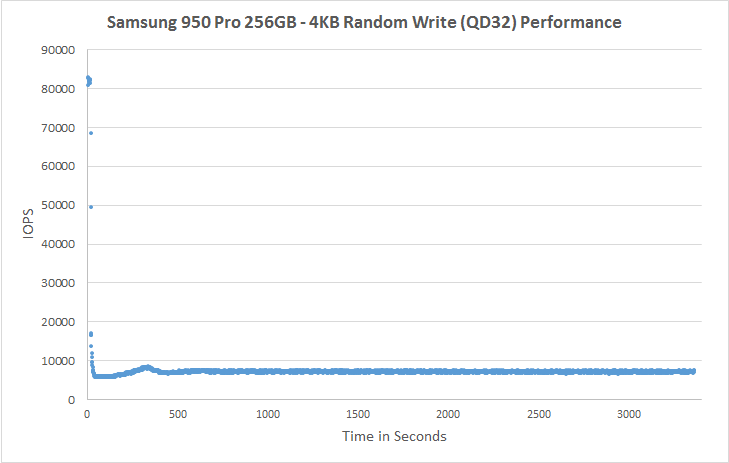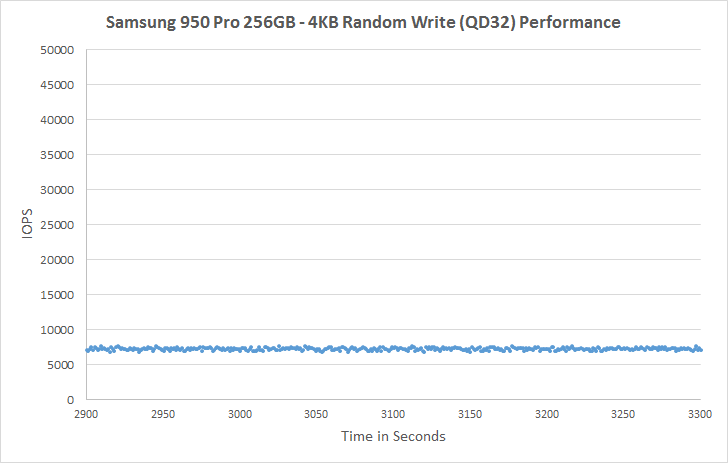The Samsung 950 Pro PCIe SSD Review (256GB and 512GB)
by Billy Tallis on October 22, 2015 10:55 AM ESTPerformance Consistency
Kicking things off, our performance consistency test saturates the drive with 4kB random writes for a full hour, with a queue depth of 32, the maximum supported by the AHCI protocol used by SATA and most PCIe drives. This puts the drive's controller under maximum stress and writes enough data to exhaust all free space and spare area on the drive. This is an unrealistic workload for any client use, but it provides a worst-case scenario for long-term heavy use, and it sheds light on how different SSD controllers behave and if their performance will hold up as they fill up.
The average of the last 400 seconds of the test gives us a steady-state IOPS rating that is usually very different from what the manufacturer specifies for a new, empty drive. We also quantify the consistency of the drive's random write performance, and provide plots of the performance over the course of the test.

Once steady state is reached, performance is determined more by the controller's algorithms than the interface speed, so it's not too surprising to see the 950 Pro performing similarly to other Samsung drives.

The consistency metric shows a surprising disparity between the two 950 Pros, with the 256GB performing much better.
 |
|||||||||
| Default | |||||||||
| 25% Over-Provisioning | |||||||||
Comparing the graphs of the two 950s shows that the inconsistency of the 512GB drive comes from frequent jumps in performance above a solid baseline. This pattern holds even for the test with overprovisioning. Graphing the power consumption over time (not shown) reveals that the periods of lower performance have lower power. If the lower performance were due to periodic background garbage collection, then we would expect power consumption to be at least as high as when the drive is performing well. Instead, it appears that the 512GB drive is experiencing thermal throttling.
 |
|||||||||
| Default | |||||||||
| 25% Over-Provisioning | |||||||||
With most of its time spent thermally limited, our 512GB sample's low average is explained. It appears that the thermal throttling mechanism is bumping the drive down to one of several discrete performance levels, rather than a continuous performance mechanism.










142 Comments
View All Comments
user_5447 - Thursday, October 22, 2015 - link
Yeah, just buy Skylake motherboard, CPU and DDR4 RAM.And I'm not saying that it's simple, I'm saying that it's possible. You don't have to do anything special after setting it up, just keep small USB drive plugged in at the back of your PC.
user_5447 - Thursday, October 22, 2015 - link
Also, you can do it without additional USB drive, if you have at least one installed SATA device.Redstorm - Thursday, October 22, 2015 - link
Still a crap solutionEssence_of_War - Thursday, October 22, 2015 - link
I have had exactly two problems with GRUB.1) When windows destroys it because lolz.
2) When I was trying to install gentoo into a zfs root with on a luks encrypted disk.
Grub is fine and has been for a while.
SyukriLajin - Friday, October 23, 2015 - link
windows shouldn't be able to mess with it if grub is installed on an external usb drive, and then setting the usb drive as the main boot device(all bios i've seen supports this). it's called chainloading, and it's not a bad hack if you don't have all the proper hardware but still want to try it. of course, it will require some technical knowledge. and because i'm poor, and can't afford a new system, if it works, it's good enough.hero4hire - Sunday, October 25, 2015 - link
If you're poor you wouldn't buy a nvme ssd. It is interesting to talk possibilities thoughEwitte12 - Saturday, October 24, 2015 - link
It didn't take much to figure out how to insert the nvme modules into a z87 motherboard. However I was prepared to replace it with a z97 if it messed up. I was NOT even considering the 600+ to go to skylake.Redstorm - Thursday, October 22, 2015 - link
Because what you propose is not a very good solution at all.eddieobscurant - Thursday, October 22, 2015 - link
The problem with that theoretical solution (which i've tried) is that windows won't let you install on it when it lists the disk drives.If you migrate an installation from a sata drive, you get a bsod upon restart due to the different ahci/nvme drive required similar to the ahci/ide for sata drives.
So there isn't a solution
Gigaplex - Thursday, October 22, 2015 - link
You'd need to use the Windows deployment tools such as DISM to apply the WIM file, rather than run the regular install wizard.